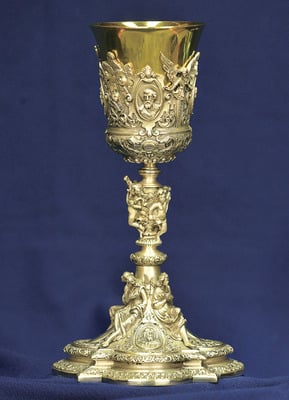What’s inside my church? Sacred vessels used during consecration
-
 Pictured above: Father Daniel Darmanin’s highly decorated chalice features angels, cherubs, Joseph, Mary and the four evangelists. (Photo by Frank J. Methe, Clarion Herald)
Pictured above: Father Daniel Darmanin’s highly decorated chalice features angels, cherubs, Joseph, Mary and the four evangelists. (Photo by Frank J. Methe, Clarion Herald)
By BETH DONZE
Clarion Herald
Let’s take a closer look at the special “dishes” that are used at the eucharistic table at Mass – items that remind us of the actual ones used by Jesus at the Last Supper.
At that meal, Jesus informed his apostles of the supreme sacrifice he was about to make (of his very life), but told them that he would be with them always through the gift of the Eucharist!
• The chalice is the sacred vessel that holds the wine that will become the Blood of Christ during the consecration. The word chalice is derived from “calix,” the Latin word for cup.
• You probably can spot the English word hiding inside the word “paten.” The paten is the “plate” that holds the host (the bread) that will become the Body of Christ during Mass.
Because they hold such precious contents – Jesus himself – the chalice and paten are typically made of gold or silver and are sometimes encrusted with jewels. There are also simpler chalices made of clay or tin.
Whatever its appearance, the chalice is such a sacred vessel in the ministry of the priest, that Archbishop Gregory Aymond personally hands each newly ordained priest his chosen chalice at the ordination Mass.
Sometimes, at the conclusion of a priest’s funeral Mass, the archbishop will hold up the late priest’s chalice and ask the congregation “Who will be the next to take up this chalice?” He asks this not only to encourage vocations to the priesthood, but because chalices often are passed on from one priest to another.
Chalices are also purchased new, as in the case of Father Daniel Darmanin, pastor of St. Margaret Mary Church in Slidell. The chalice, a gift from Father Darmanin’s family and close friends, was chosen for its incorporation of angels, cherubs, Joseph, Mary and the four evangelists.
• There are two more sacred vessels every Catholic should know about. The cup that holds a large number of hosts, often held by the priest during Communion, is called the ciborium. A smaller, circular sacred vessel called the pyx is used to safely transport consecrated hosts to the homes of those who are unable to attend Mass in person.
[email protected]
